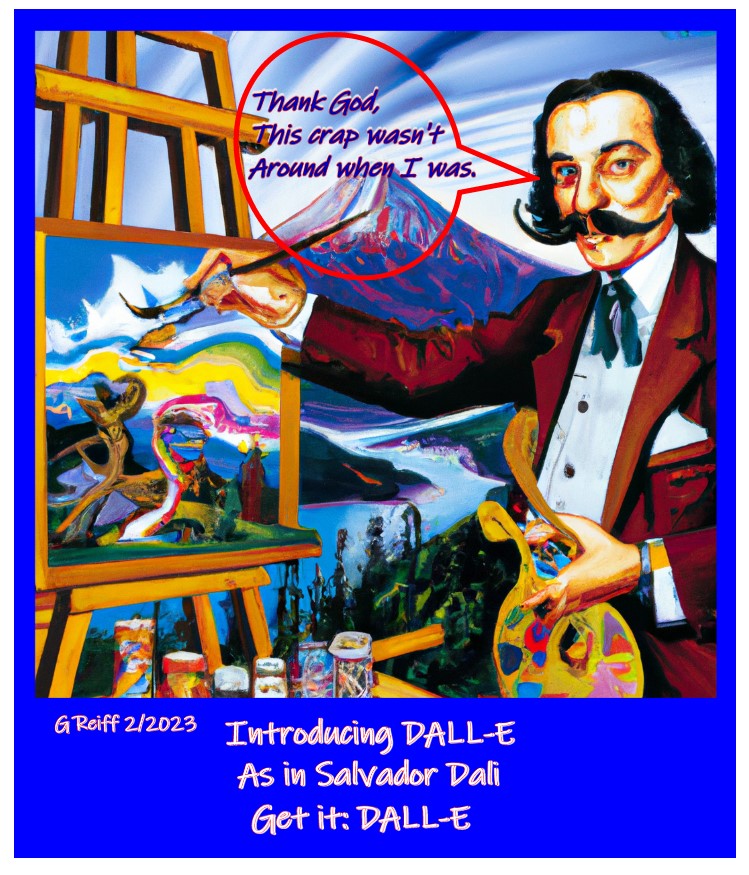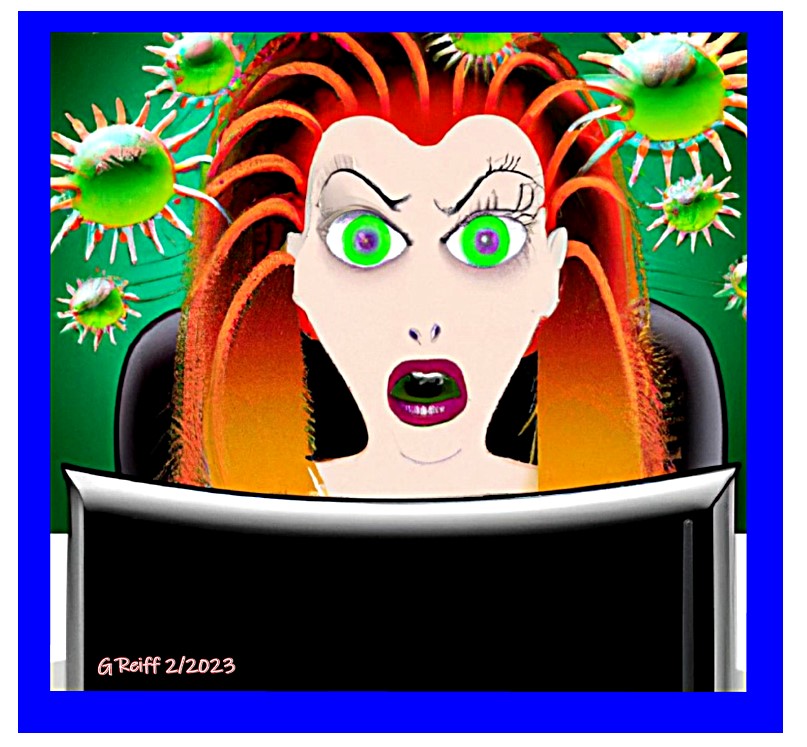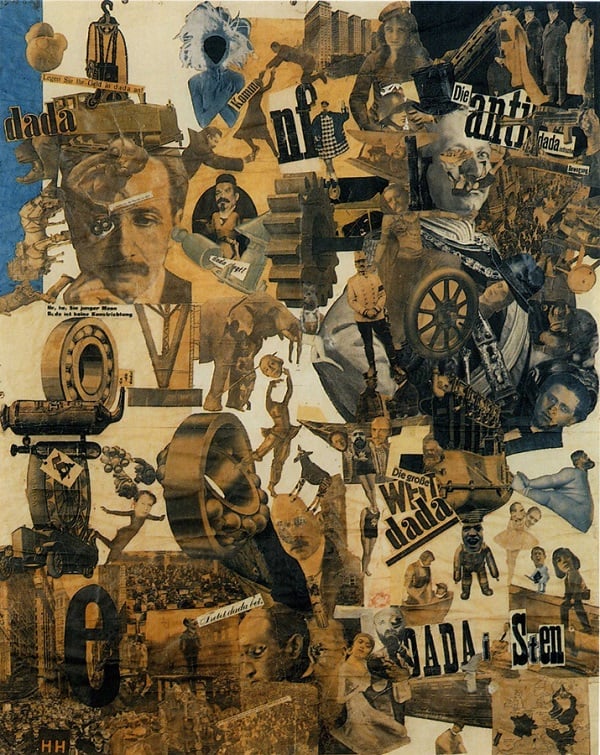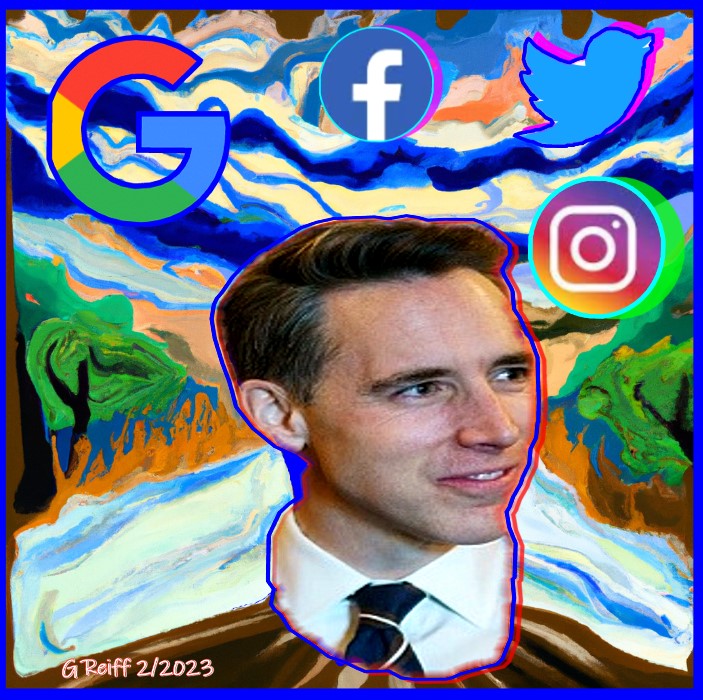Introducing AI Image Generation Application —
DALL-E
The Complete Magical Mystery Tour With a Stop in DadaLand

source:
DALL-E
Prompt: a colorful graphic image artist Salvador Dali in his
50s with long multicolored shoulder length hair and a long moustache and
goatee holding a paintbrush
and multicolored palette. the ends of
the moustache and goatee have flames coming out of them. the artist is
standing in front of an easel a landscape painting
of mountains,
trees, and clocks that all appear to melting. the entire image is set in
front of a the same landscape as the image on the canvas
Regular readers of The Dispatches have likely noticed a new graphical
element to the webpages. The comic like images you saw on the
previous pages were created by Artificial Intelligence Image Generating
Application websites. Although I did use one graphic from
DeepAI.org, and the prompt was "Graphic
image of a child holding a smartphone in the style of edvard munch,"
to produce the image below, the rest of the images were generated from
DALL-E.
DALL-E is from the same folks who
gave us ChatGPT. It's the Yin to their Yang. The
DALL-E application seems more complete than that at
DeepAI.org. The real
selling point was more credits at signup.
DALL-E gives a user 50
free credits for the first 30 days; and then 15 free credits every 30
days afterward. After the credits expire, there are various billing
schemes offered by
DALL-E.
DeepAI only gave 15 free credits, and things got a
bit convoluted from there. So, for my purposes,
DALL-E, obviously
was a better choice.

source:
https://deepai.org/
Prompt: Graphic image of a child
holding a smartphone in the style of edvard munch
In the case of either site, I did not get the combination of "The Scream" and a child holding a cellphone that I was aiming for. That was early in my foray into Image Generating AI technology, and it quickly occurred to me that I could quickly eat up all those credits. Experimentation can get real costly real fast. This can get addicting — it is that much fun, at least to me.
When you first browse to the DALL-E website, the screen below appears. All various elements of the web experience are very straight forward; I did not encounter any gotchas. I used my Google credentials to login.

The free side of the website is reportedly slower when compared to the pay side of DALL-E. But even on my current very slow connection, the slowness wasn't all that enervating.
When DALL-E opens to the main page, the visitor is greeted with a prompt to type the textual description of the desired image.

The Collections link will display the entire collection of a user's generated images in a larger thumbnail format, as shown below.

I show the prompt I used to generate the image that was used to close out the article on the NSA Home Network document. When you complete the prompt and click the Generate button, the application starts to perform its magic.
As the possible images are generated, so does the screen on the right that shows the visitor a thumbnail history of all the image choices that have been generated for that visitor's logon. This image library can be cleared by the user. Finally, four choices generated by the prompt appeared.

Each generated image has a rainbow rectangle in the lower
right corner of each image that serves as a
watermark that details that the image came from
DALL-E.
I have also noticed a random swash of red on the images that I had ultimately
downloaded. I was able to crop the square watermark, but the red
swash was sometimes there to stay. It is noticeable right under
Dali's left eye socket on the first image of this article. The placement
of the red swash on the the Dali image
seemed random, and thus was less a distraction and blended in better
than on some of the other images, given my stylistic
themes. The prompt, "colorful graphic showing a
frantic woman with red hair and green eyes staring at virus infected
computer," came very close to the image I had in mind. But my
mental image, and thus my prompt, were not so specific in fine detail.

Source:
DALL-E
Prompt: colorful graphic showing a frantic woman with red hair
and green eyes staring at virus infected computer
The greater are the textual details the prompt gives to the AI, the
more exact are the images that are generated. There is a bit of a learning curve
in writing prompts. My first attempt resulted in images unusable for
my editorial purposes. I realized greater specificity in my prompt
may have returned an image better matching what I was hoping for.
I soon learned simply hoping for an image that reflected whatever I had in
mind would quickly consume all my credits. I began to write my
prompts first using Notepad. That really helped me better focus on
what I wanted my image to convey. I then pasted the Notepad text
into the prompt.
My visual imaging techniques and software haven't changed since before Y2K. I call my melding of different
images cropped and pasted to create a new image with its own theme,
Digital Dada. Dada was an art movement that was in vogue in the
early 20th century, mostly
in Europe. Dada was particularly active in Weimar Germany during the 1920s. This
art movement was also a protest movement against Hitler's and the Nazi's
rise to power. Thus, much Dada art was political in nature, and
specifically Anti-Hitler. Like
Punk Rock is a musical
style that rebelled against what it saw as the formula rock and roll of the
late 1960s and early 1970s, and which the Punks thought was anathema to
the
rebellious rock and roll spirit, so Dada, in its time, was in much the same manner
as was Punk Rock, a reaction to the soft diffused visions of Impressionism,
Expressionism, and other
early modern artistic styles. In many ways,
Dada was Anti-Art. Dada was more, as Man
Ray explained, "a state of mind."
Ibid.
Some of the most famous and
enduring examples of Dada Art are the various
photomontages that
were produced and served as political statements critical of life in Weimar
Germany. These were my first introductions to Dada Art when I was
a teenager. An example of a Dada photomontage by Hanna Hoch is shown below. Entitled "Cut with the Kitchen Knife through the Last Weimar Beer-Belly
Cultural Epoch in Germany." A photomontage is essentially
an analogue
cut and paste of other photos. In today's world, copyrighters
would have killed the Dada movement in its infancy.

source:
https://news.artnet.com/art-world/words-wisdom-dada-genius-hannah-hc3ch-birthday-350867
So this idea of Dada art is what I always have in mind when I create my own cut and paste montage, such as the image below. Senator Josh Hawley seems obsessed with Social Media, almost to the point of an intense fixation, bordering on psychosis. So I wanted to place Senator Hawley in a Surrealistic Setting reflecting a psychotic state. DALL-E did not return a specific image of Edvard Munch's "The Scream. I considered how that might be a copyright issue. DALL-E is very cognizant of copyright issues, and tries to work within the confines of the copyright laws. It also might have been that I did not exactly prompt for a portrait in the style of "The Scream." But I was burning through my credits. The AI did, however, generate images very much in the style of Munch. Here is where I really started to carefully word my prompts, writing the prompts first in Notepad to get my exact wording. And then copying the Notepad text into the DALL-E prompt, The prompt was: "landscape background in the style of edvard munch the scream." Below are the four choices I was offered for the prompt.

Since my intention was to position a cutout of Hawley from the neck up, the fourth image was perfect for my idea. Also, the background lent itself to other cutouts I had made of the logos of Google, Facebook, Twitter, and Instagram. All four of which must be the stuff of Senator Hawley's nightmares, whether awake or sleeping. My parts of my vision were now complete. I can create my art and make my statement as a 21st century Dadaist.

I call this work "Senator Josh Hawley's Bad
Trip."
While in the learning phase of my adventures in
DALL-E, and thus when I was not on top of my game
enough to save the prompts, I discovered an upload feature.
There is a feature of
DALL-E on the second screen that allows a user to
upload a photo and build a new image based on the content of the photo.
This brought about one notable failure; but like many failures in the
creative process, this failure opened up new and surprising avenues of
expression.
DALL-E states clearly this upload feature is in
Beta, and not yet finished technology. Nonetheless, I uploaded a
photo of me playing guitar.
The prompt instructed the AI to turn
the image of me and my guitar into a Cubist image in the style of
Pablo Picasso's Cubist Guitarists. Many Cubist Guitarists were
offered, but none of those images looked like me redone in
Cubism.
I changed the prompt just a little. Then one set of images were
offered that was a different take on what I had imagined or asked for.
It was the image of me that had been uploaded sitting as a model for an art
student to paint a guitarist in the style of Cubism.
Interestingly, the uploaded image was tightly cropped. But the AI
returned much of the original content that had been cropped out of the jpg
file that I had uploaded. At least, that's the
way it looks. Note to
self: Careful with uploaded images. You may crop out unwanted
content, but the AI will find that content and possibly display that content.
The first image you see is the jpg file I had uploaded to
DALL-E. The second was entirely the idea of
the AI.
Upon further analysis, maybe I am supposed to be giving a performance?


Like so many things on the Internet that are really very much fun to work with, and yet practical at the same time, DALL-E can become quite addicting. It's simply a BLAST to use! For better or worse, I really can't afford any fierce addictions right now. So I must conserve my remaining 34 credits for future Dispatches From the Front.
They that make a graven image are all of them vanity;
and their
delectable things shall not profit;
and they are their own
witnesses;
they see not, nor know;
that they may be ashamed.
— Isaiah 44:9